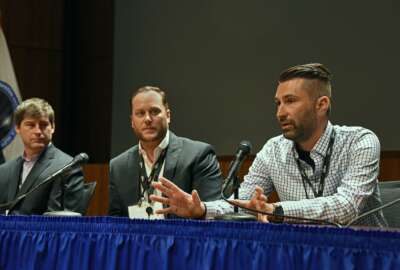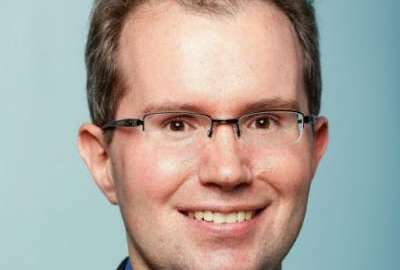
FCC’s Bray taking talents to NGA to lead new innovation, big data effort
David Bray, the Federal Communications Commission chief information officer, is leaving after four years to join the National Geospatial-Intelligence Agency’s...
David Bray, the Federal Communications Commission chief information officer, is heading off to a new position. Bray announced to staff that he will be the new Chief Ventures Officer at the National Geospatial-Intelligence Agency.
“The new Chief Ventures Officer role will stretch my leadership abilities further in directing new public-private partnerships, adoption of machine learning and artificial intelligence, as well as changes in NGA’s mission processes, workforce, and acquisition models,” Bray wrote in the email to staff. “The role collectively will present an entirely new set of opportunities for me to listen, learn, and champion even more positive #ChangeAgents across a 15,000+ person joint military, intelligence, and civilian organization. It will be the first role of its kind in the U.S. Government focused on completely transforming the business model of a large organization.”

Bray will start in his new position in late July and Christine Calvosa will be acting FCC CIO after Bray leaves.
NextGov first reported Bray’s decision to move to NGA.
“NGA sits on an amazing and broadly untapped resource. We have labeled imagery, data and analysis going back decades. In a world of deep learning, historic data and ground truth are immensely valuable. Some have even called data ‘the new oil.’ At the same time, we know that industry has valuable data, as well as the talent, creativity and ability to make something out of nothing to create new algorithms and whole concepts. We must tap into that. So, we propose the creation of a data investment brokerage. NGA would invest our data, our analysis and maybe even our data exhaust – the byproducts – into promising startups, companies and ideas,” said Robert Cardillo, the director of NGA, in a speech at the GEOINT conference in San Antonio, Texas on June 5. “The goal would be to obtain a return on that data in the form of new or transformed data, new algorithms, trained machine vision approaches or an application of linked software. Our approach to this initiative is now in formation, and we look forward to developing this type of data-centric synergy with any and all interested partners. It’s a bold idea with many challenges – from authorities to declassification to licensing – and it definitely falls into the category of taking a risk.”
Cardillo said Bray would lead the new Office of Ventures and Innovation, and work alongside Dr. Anthony Vinci to address these big data challenges and create new public-private partnerships.
“David is a true change agent, who’s currently serving as the CIO at the FCC and I expect big things from him,” Cardillo said.
Bray said his new role will involve changing the “agency’s business processes and behaviors to shift from mapping the world to ‘mapping and modeling the world,’ while exploring public-private partnerships to accelerate this shift.”
Over the last four-plus years, Bray has transformed the FCC’s IT infrastructure and practices. He moved the commission to the cloud and reduced its spending on legacy technology by 35 percent.
This is Bray’s second stint in the intelligence community. From 2010 to 2013, he served as the national commission executive director and senior national intelligence service executive for the National Commission (Congressionally Chartered) and Office of the Director of National Intelligence. In that role, he led a team to make recommendations for new efforts and reviewing future science and technology plans of the entire IC.
Cardillo said NGA has been putting in the tools in place to tackle the big data problem over the last few years through a series of partnerships with federal, private sector and academic organizations.
One such initiative is called the Commercial Initiative to Buy Operationally Responsive GEOINT (CIBORG) program.
Cardillo said the CIBORG initiative provides NGA and others in the federal community rapid and easy acquisition of commercial imagery, data, analytic capabilities and services.
“It enables organizations to access and purchase commoditized commercial data, products and services directly through the General Services Administration to satisfy their unique mission demands,” he said. “GSA has added 10 vendor contracts to CIBORG with another 20 in the process of being added. And, so far in this fiscal year, NGA has committed $40 million via CIBORG. This initiative supports our role to become the GEOINT broker of choice.”
A second example is the new National System for Geospatial-Intelligence Open Mapping Enclave (NOME), which lets NGA’s partners crowd-source and create foundation data in areas with no existing coverage.
“Right now, there are more than 600 Web users from 15 contributing member nations on our World Wide Web presence and more than a thousand users on our top secret domain,” he said. “Later this summer, we’ll expand NOME to our secret domain, so many more military users can access it.”
Bray also should have some modern IT tools. Cardillo said NGA also moved to the cloud to launch GEOINT Services, which is delivering content and services to its customers.
Among the priorities of the new office will be help NGA find and implement new tools and training. Cardillo said NGA needs to continue to focus on discrete data and tools– Activity Based Intelligence, Structured Observation Management and Object-Based Production—as well as begin to automate its workflow.
“It’s about driving effective collection and analysis. Remember those analysts watching every frame of every game? Our goal is to automate 75 percent of their tasks, so they have more time to analyze that last play and more accurately anticipate the next one. So they can look much harder at our toughest problems – the 25 percent that require the most attention. So they know what to do on fourth down,” he said. “Fortunately, we’re already seeing that potential. We’ve had several resounding successes over the last year – here’s one of just many. [L] et’s look at a new GEOINT Service we call Beachfront. Beachfront automates the creation of new coastline using commercial satellite imagery sources. This is the immense river delta system on the border of India and Bangladesh. It would have taken one analyst five hours to produce these vectors manually – it took Beachfront less than six minutes. 300 minutes to six. That’s a lot of time freed up by computers to perform analytic work that today only humans can do.”
A second priority area for Bray and his new office will be around the workforce. Cardillo said every NGA employee need to be data literate and have computational skills.
“Of course, we’ll still need creativity, intuition, critical thinking and intellectual diversity. So our vibrant recruiting pipeline is open. Because we’ll need people who can solve problems we haven’t even thought of yet. The smart money is on creating user-driven and user-developed solutions,” he said. “When it comes to GEOINT Professional Certification, we’re definitely having an excellent ride. NSG personnel now have the opportunity to get eight operational certifications with three more programs due online this year. We’ve administered nearly 14,000 tests and awarded more than 9,000 certifications to GEOINT professionals worldwide. We have the largest intelligence certification program in the Department of Defense. And the National Commission for Certifying Agencies has accredited three different programs: GEOINT Fundamentals, Imagery Analysis and Aeronautical Analysis. This will all lead to shared standards, shared terminology, shared tradecraft, shared everything – more accessible data for all of Team GEOINT. It will also enable more confidence in our profession across the board. So, as I hope you can tell, I’m bullish about this GEOINT Revolution and the future of our profession.”
Copyright © 2024 Federal News Network. All rights reserved. This website is not intended for users located within the European Economic Area.
Jason Miller is executive editor of Federal News Network and directs news coverage on the people, policy and programs of the federal government.
Follow @jmillerWFED
Related Stories






